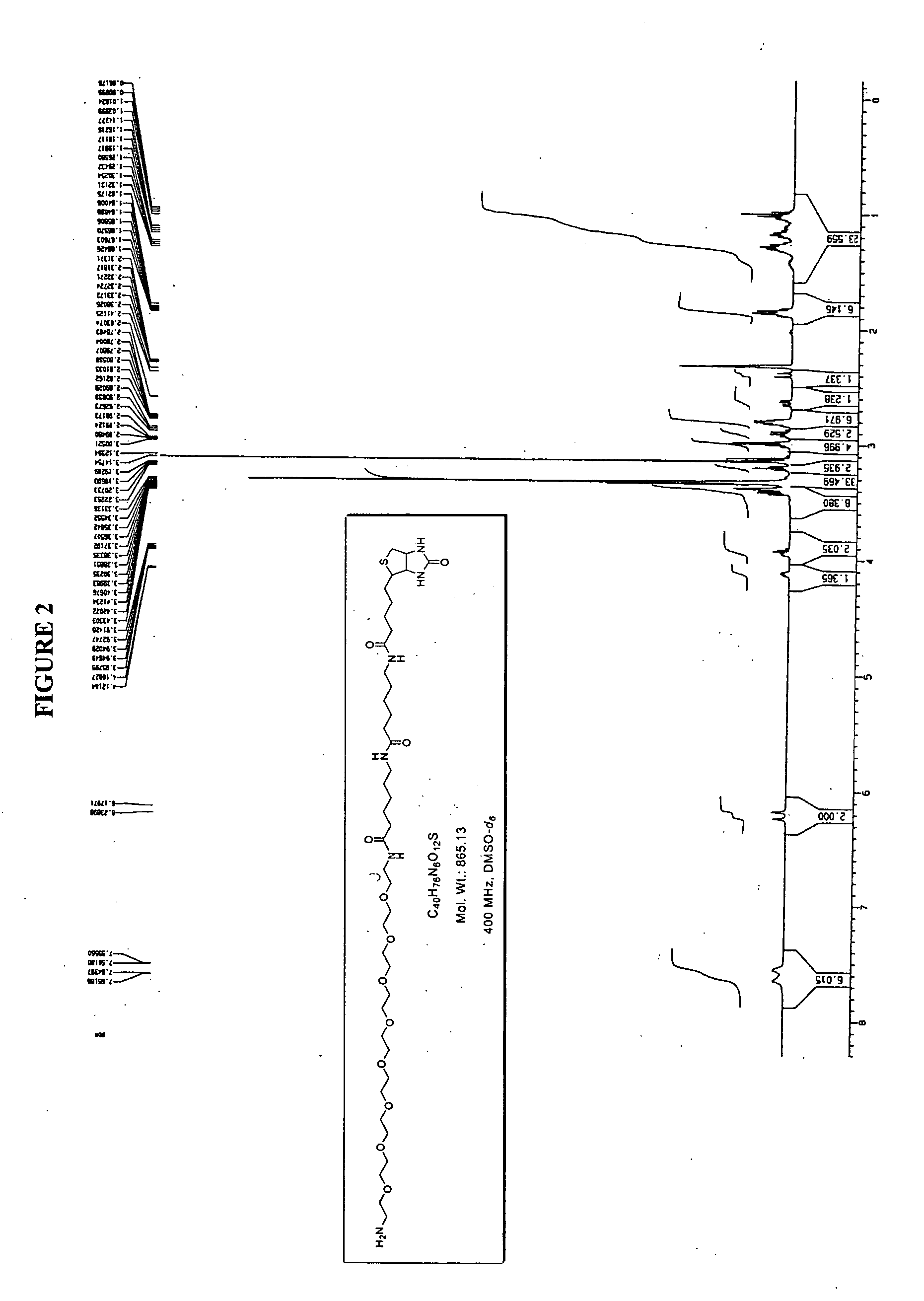Conjugated small molecules
a small molecule and conjugate technology, applied in the field of conjugate small molecules, can solve the problems of loss of enzymatic activity, loss of ability to follow the conjugate in a bioanalytical procedure, and limited utility of conjuga
- Summary
- Abstract
- Description
- Claims
- Application Information
AI Technical Summary
Problems solved by technology
Method used
Image
Examples
example 1
The Synthesis of Bromo-Peg-azide
[0133] The compound (2) was synthesized according to the scheme below:
Azido PEG (1) (3 gm, 7.58 mmol, 1 eq) was dissolved in a minimal amount of CH2Cl2 (DCM). The mixture was flushed with argon and cooled to 0° C. by ice water bath. Thionyl bromide (1.9 gm, 9.14 mmol, 1.2 eq) was then added drop wise to the mixture. The reaction mixture was stirred at 0° C. for 15 min., warmed to room temperature and stirred overnight. The reaction mixture was poured into a small amount of water and sodium bicarbonate was added to neutralize the mixture to pH of about 7. The mixture was then extracted twice with DCM. The organic layers were combined, washed with brine, dried over MgSO4, and filtered. The crude mixture was purified by HPLC to obtain product (2).
example 2
Synthesis of Iodo-PEG-Azide
[0134] The compound (4) was synthesized according to the scheme below:
Azido peg (1) (3 gm, 7.58 mmol, 1 eq) was dissolved in a minimal amount of CH2Cl2, and triethyl amine (1.53 gm, 15.12 mmol, 2 eq) was added. The reaction was flushed with argon and cooled to 0° C. by ice water bath. Methane sulfonyl chloride (956 mg, 8.35 mmol, 1.1 eq) was added drop wise to the mixture. The reaction stirred at 0° C. for 15 min and then warmed to room temperature. After 4 h, the reaction was stopped by the addition of water, and the aqueous solution was twice extracted with CH2Cl2. The organic layers were combined, washed with brine, dried over MgSO4, filtered, and the organic solvent removed under reduced pressure to yield the intermediate PEG product (3).
[0135] The air dried compound (3) was dissolved in a minimal amount of acetone. Potassium iodide (3.15 gm, 18.98 mmol, 2.5 eq) was added to the solution, and the reaction was refluxed overnight at 40° C. under arg...
example 3
Synthesis of Allyl-PEG-Azide
[0136] The compound (6) was synthesized according to the scheme below:
To a stirred suspension of sodium hydride (334 mg, 13.92 mmol, 1.1 eq) in dry DMF at 0° C. under argon was added drop wise a solution of azido peg (1) (5 gm, 12.64 mmol, 1 eq) in dry DMF. The reaction was allowed to warm to room temperature and stirred for 2 h. The reaction solution was cooled to 0° C. by an ice water bath, and a solution of allyl bromide (5) (1.53 gm, 12.65 mmol, 1 eq) in dry DMF was added drop wise. The reaction solution was allowed to warm to room temperature, stirred overnight, and the salt precipitate was removed by filtration. The filtrate was purified by HPLC to yield the product (6) as a light yellow oil.
PUM
| Property | Measurement | Unit |
|---|---|---|
| temperature | aaaaa | aaaaa |
| temperature | aaaaa | aaaaa |
| porosity | aaaaa | aaaaa |
Abstract
Description
Claims
Application Information
 Login to View More
Login to View More - R&D
- Intellectual Property
- Life Sciences
- Materials
- Tech Scout
- Unparalleled Data Quality
- Higher Quality Content
- 60% Fewer Hallucinations
Browse by: Latest US Patents, China's latest patents, Technical Efficacy Thesaurus, Application Domain, Technology Topic, Popular Technical Reports.
© 2025 PatSnap. All rights reserved.Legal|Privacy policy|Modern Slavery Act Transparency Statement|Sitemap|About US| Contact US: help@patsnap.com



